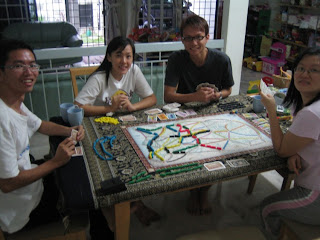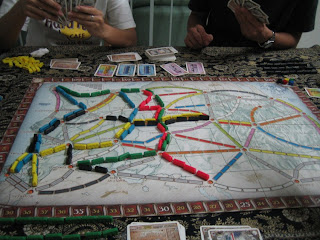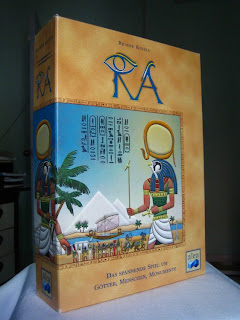Mon 1 Sep 2008 was a public holiday. Chee Seng was back in KL from Singapore, so we had planned a gaming session beforehand. He brought along two friends, Sui Jye and Jing Yi (a couple), who were new to boardgames. It has been a while since I had the chance to introduce boardgames to new players, and also I rarely get the chance to play with four or more players. In picking games, I decided to focus more on newbie-friendly ones, but I also took the opportunity to bring out Hoity Toity, which I played once 4 years ago in Taiwan. I have traded for this (my first and only game trade ever) some time ago but never had the right opportunity to bring it out because this needs more people to be fun. Four players is probably the minimal for this to be fun. I imagine it would be even better with 5. It supports 6, but I'm not sure how that would be.
We played (in this order, if I am not mistaken) Risk Express, Mamma Mia, Hoity Toity, Pandemic (twice),
Coloretto, Ticket To Ride. I think the new friends enjoyed themselves. Sui Jye seemed to like Ticket To Ride and the train theme. He told me he has played Diplomacy before, and some games ended with friends not willing to speak to one another. I wonder what he thinks of these German games. He seemed to like Pandemic too, and it was funny to see how concentrated and serious he was when thinking what to do on his turn. Chee Seng seemed to like Pandemic a lot. After losing our first game at easy level, he was first to request for another game. Pandemic is indeed a charming game. Quite easy to learn and intuitive. If we play this again I'm going to get them to play the normal difficulty level, now that they have beaten the easy level game on their second attempt.
Chee Seng was the biggest winner of the day, winning Mamma Mia and Hoity Toity, both by big margins. Sui Jye didn't win any game (I don't count Pandemic since it's a cooperative game). Jing Yi won Risk Express, which came down to the very last territory - Australia, when everyone's territories were safe, so it whoever conquers Australia would end the game and win the game. In a twisted way that kind of reflects the regular Risk where many people say that whoever controls Australia and turtles there will eventually win the game. I won Coloretto. Michelle (who only joined us for the last game) won Ticket To Ride. We have not played Ticket To Ride with 5 players for a long time, and it was quite tense because of the congestion.

Sui Jye, Jing Yi, Chee Seng and Michelle playing Ticket To Ride.

The east coast (which is the left side, since I'm taking the photo from Canada's direction) was very congested, with many players making disjointed paths, especially Chee Seng's black ones, which thankfully were eventually linked up. If we had been playing with a cutthroat group, there would have been plenty of vicious blocking. It was only in the later part of the game that some of us branched out towards the west.
Let's talk about Hoity Toity (unfortunately I didn't take a photo), aka Adel Verpflichtet (I think this was the original name, and this was what won the SdJ), By Hook or Crook and Fair Means or Foul. It is not new to me, but it's been so long since I played this (and I only played once) that it's like playing it for the first time. I (and Michelle) had a bad experience with this when we played it last time. We were at Witch House in Taiwan, and we played it with 2 other customers who have played it before. They taught us how to play (if I remember correctly), and then proceeded to slaughter us in the game. We didn't have much idea what we were doing or how to strategise. We were quite lost. That game left a bitter taste. Later at a local gaming event I traded away Domaine for this. I wanted to give it another chance, because I believed it was the players that spoiled the experience for us, and not the game. And thankfully I did so, because I now find that indeed this is a fun game.
In Hoity Toity, you play a snobbish artifact collector who likes to show off his/her collection to his/her friends. You can buy artifacts, you can steal them from your "friends", you can even steal money from them, and you can also get a detective to catch your friends' thieving accomplices. But, the main way to win the game is to show off your stuff. Every turn, players first simultaneously and secretly decide whether they want to go to the auction house or the castle, and then similarly they decide what they want to do at these locations. At the auction house you can try to be the highest bidder so that you can buy the artifact on sale, or you can try to steal the money paid by the buyer (if there is one). At the castle, you can show off your goods, or send a thief to steal the artifacts on display, or send a detective to arrest the thieves. Some call this game a glorified version of rock-paper-scissors, but I think that's not very fair. Indeed there is the guessing of what your opponents will do, but I don't associate rock-paper-scissors with that much fun.
Playing guessing (i.e. rock-paper-scissors) twice every round sounds rather repetitive, but I find that there are a few things which keep the game interesting. The victory points awarded for showing off your artifacts differs from time to time, depending on the position of the leading player. When the reward is higher, players will be more tempted to go to the castle to display their artifacts. The artifact available for sale also changes, and sometimes when a good one turns up then players will be more tempted to go to the auction house. Players start with a limited amount of money, and they are fixed amounts on a few cards. This pool of money cards in the game will gradually increase, and money will become more and more scarce. The only way for a player to earn money is to steal it from the auction house when another player buys an artifact. Every time there is a purchase and no successful theft, the money pool in the game dwindles. So there is a pressure on the players as the game progresses. However you also need to remember money means nothing at game end. They are just the means to an end. Winning is all about showing off your impressive collection.
The game we played was quite fun, with taunting and teasing and trash talking. There were groans and cheers when the wrong / right guesses were made. Chee Seng really ran away with the game. From about mid point onwards, he sprinted ahead and never looked back. I think I did rather badly, because I often got outguessed, which means I didn't benefit much or at all from my chosen action. I think I'm quite bad at double guessing. I still remember two games of Lord of the Rings: The Confrontation against Ricky at Port Dickson when he guessed my every card play. I wonder whether it's other people seeing through me too easily, or I'm bad at reading my opponents.
So, I'm happy with having gotten Hoity Toity in the trade. This is a family game I can probably play with my children sooner that the usual heavy Eurogames that I like. And next time I should try to play with 5 or 6 to see whether it gets even better.



